| Sintra
/ Cape Roca / Cascais |
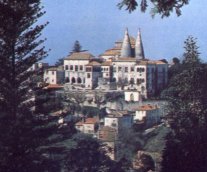 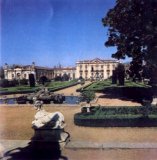 Departure
to Sintra, a small delightful town in the forest covered Mountain
of Sintra, immortalized as "Glorious Eden" by the World famous
poet Lord Byron. Located about 30 kilometers northwest of Lisbon,
there will be a visit to the Royal Palace of Sintra, a fabulous
royal residence of many Portuguese Kings, with wings and halls
dating from the 13/14th Centuries. Sintra is excellent for shopping
souvenirs and handicraft, and there will be time at leisure.
Descending the mountain on to Cape Roca, the Western-most point
of continental Europe, a stop will be made by the cliffs over
the Atlantic Ocean. Then following the coastline the tour will
pass by Guincho Beach, Boca do Inferno (Hell's Mouth) an ocean
carved spectacle in rock. Arriving at the old fishermen village
of Cascais that in the 1940's was chosen as residence by exiled
European Royalty, a stop will be made by the lovely bay filled
with fishing boats. Departure
to Sintra, a small delightful town in the forest covered Mountain
of Sintra, immortalized as "Glorious Eden" by the World famous
poet Lord Byron. Located about 30 kilometers northwest of Lisbon,
there will be a visit to the Royal Palace of Sintra, a fabulous
royal residence of many Portuguese Kings, with wings and halls
dating from the 13/14th Centuries. Sintra is excellent for shopping
souvenirs and handicraft, and there will be time at leisure.
Descending the mountain on to Cape Roca, the Western-most point
of continental Europe, a stop will be made by the cliffs over
the Atlantic Ocean. Then following the coastline the tour will
pass by Guincho Beach, Boca do Inferno (Hell's Mouth) an ocean
carved spectacle in rock. Arriving at the old fishermen village
of Cascais that in the 1940's was chosen as residence by exiled
European Royalty, a stop will be made by the lovely bay filled
with fishing boats.
Return to Hotel passing by Estoril.
| Óbidos
/ Nazaré / Batalha / Fátima |
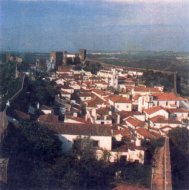 Depart
to the Northern auto-route to Óbidos one of the most charming
Portuguese villages, completely enclosed within the ramparts
of the Medieval Castle. Walking visit with entrance by the 18th
Century arch covered in glazed tiles (azulejos), bright white
small houses along cobblestone narrow streets, flower pots on
window-sills, Gothic and Renaissance churches specially the
beautiful Church of Santa Maria reminds the importance of Óbidos
past. Depart
to the Northern auto-route to Óbidos one of the most charming
Portuguese villages, completely enclosed within the ramparts
of the Medieval Castle. Walking visit with entrance by the 18th
Century arch covered in glazed tiles (azulejos), bright white
small houses along cobblestone narrow streets, flower pots on
window-sills, Gothic and Renaissance churches specially the
beautiful Church of Santa Maria reminds the importance of Óbidos
past.
Local artisans and craftsmen still using the old techniques
show their wares in the small shops along the streets. Continuation
of the tour to Nazaré, the most famous fishing town in Portugal.
Among the bright colored rowing-boats moored on the beach bathed
by the Atlantic Ocean, one may watch the fisherfolk bring in
the nets. A superb view is enjoyed from the "Sítio", a belvedere
on top of the hill while in the streets you may observe women
still wearing the traditional 7 skirted costumes. Lunch will
be served at a local restaurant.
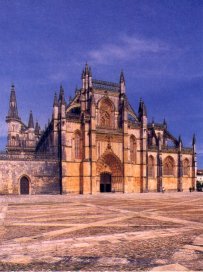 The
tour will proceed to Batalha for a visit to the superb Monastery
of Santa Maria da Victória celebrating the victory against the
Castillians in 1386 in the Battle of Aljubarrota. This monument
built in 1388 is the most beautiful example of the Portuguese
Gothic architecture, later in 1509 were added the Unfinished
Chapels and Cloisters in "Manueline" and in 1563 the Renaissance
Chapels and Cloisters. The
tour will proceed to Batalha for a visit to the superb Monastery
of Santa Maria da Victória celebrating the victory against the
Castillians in 1386 in the Battle of Aljubarrota. This monument
built in 1388 is the most beautiful example of the Portuguese
Gothic architecture, later in 1509 were added the Unfinished
Chapels and Cloisters in "Manueline" and in 1563 the Renaissance
Chapels and Cloisters.
Departure to Fátima, the well known Roman Catholic Marian Shrine.
Visit the Basilica and the Chapel of Apparitions that marks
the spot where the 3 shepherd children had the visions in 1917.
Time at leisure for individual activities.
Return to Lisbon by the new auto-route that crosses the provinces
of Ribatejo and Estremadura.
 Departure driving through
this remarkable city built nearly 2.500 years ago passing buildings
dating from the 18th Century and along mosaic paved streets. Departure driving through
this remarkable city built nearly 2.500 years ago passing buildings
dating from the 18th Century and along mosaic paved streets.
The first stop will be high above the city at the Castle of
Saint George, an 8th Century fortress from whose ramparts can
be enjoyed a superb view of the old boroughs and the River Tagus.
Next a small walking promenade through the winding streets of
the Medieval borough of Alfama, who offers the picturesque flavor
of an old popular residential area. An unique sight of narrow
streets, friendly residents and 16th Century buildings.
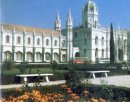  Then the tour will proceed
to the historic Lisbon's borough of Belém. Visit the Royal Coaches
Museum with the largest and most important collection of carriages
in the World from the 17th to the 19th Centuries. Next follows
the visit to the Monastery of the Jerónimos (Hieronymite Monks)
built in 1502 and the finest example of the Gothic-Naturalist
(the ambient decoration named "Manueline"). The splendid church
with chapels and the main-altar in Gothic-Renaissance style
will be visited. Then drive along the River Tagus left bank
stopping by the Tower of Belém, an 16th Century fortress and
by the Monument to the Sea Discoveries. Then the tour will proceed
to the historic Lisbon's borough of Belém. Visit the Royal Coaches
Museum with the largest and most important collection of carriages
in the World from the 17th to the 19th Centuries. Next follows
the visit to the Monastery of the Jerónimos (Hieronymite Monks)
built in 1502 and the finest example of the Gothic-Naturalist
(the ambient decoration named "Manueline"). The splendid church
with chapels and the main-altar in Gothic-Renaissance style
will be visited. Then drive along the River Tagus left bank
stopping by the Tower of Belém, an 16th Century fortress and
by the Monument to the Sea Discoveries.
Return to Hotel.
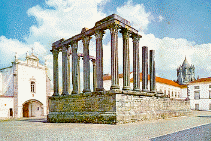 Departure
by the Bridge 25th April over the River Tagus passing by Montemor
on to Évora. Classified as "Museum Town and
World Heritage" by the Unesco in 1986, Évora was first
known by the Celts as Ebora, by the first Roman settlers as
Ebora Cerealis and in 27 BC as Liberitas Julia.
In the suburbs of Évora there are cromlechs, menirs
and dolmens as well as remains from the Neolithic 3.500
BC. In Medieval times the town held the courts of
the Portuguese Kings of the 1st dynasty (Afonsina) since 1165
and of the 2nd dynasty (Avis) up to 1559.
The Roman-Gothic Cathedral dating from 1186,
the Church of St. Francis built in 1480 with the
macabre Chapel of Bones,
the ruins of the Roman Temple of Diana are some
of the places of great interest that may be visited.
Small streets with Manueline (Gothic-Naturalist) geminated-windows
and porticos as well as the "Moucharabieh" verandahs
of Mudejar influence, lead to the Praça do Giraldo, the
meeting point of Évora's inhabitants. Lunch
will be at a regional restaurant. After lunch
some time at leisure …….. Departure
by the Bridge 25th April over the River Tagus passing by Montemor
on to Évora. Classified as "Museum Town and
World Heritage" by the Unesco in 1986, Évora was first
known by the Celts as Ebora, by the first Roman settlers as
Ebora Cerealis and in 27 BC as Liberitas Julia.
In the suburbs of Évora there are cromlechs, menirs
and dolmens as well as remains from the Neolithic 3.500
BC. In Medieval times the town held the courts of
the Portuguese Kings of the 1st dynasty (Afonsina) since 1165
and of the 2nd dynasty (Avis) up to 1559.
The Roman-Gothic Cathedral dating from 1186,
the Church of St. Francis built in 1480 with the
macabre Chapel of Bones,
the ruins of the Roman Temple of Diana are some
of the places of great interest that may be visited.
Small streets with Manueline (Gothic-Naturalist) geminated-windows
and porticos as well as the "Moucharabieh" verandahs
of Mudejar influence, lead to the Praça do Giraldo, the
meeting point of Évora's inhabitants. Lunch
will be at a regional restaurant. After lunch
some time at leisure ……..
Return to Lisbon driving by olive-tree groves
and cork-oak woods.
|
